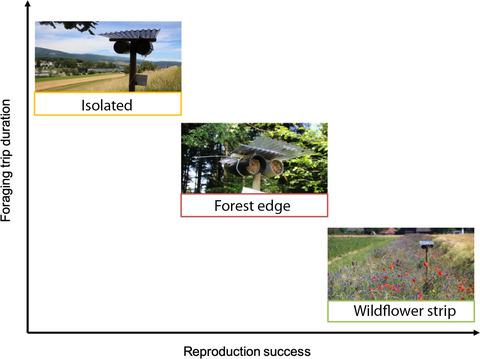当前位置:
X-MOL 学术
›
J. Appl. Ecol.
›
论文详情
Our official English website, www.x-mol.net, welcomes your
feedback! (Note: you will need to create a separate account there.)
Wildflower strips enhance wild bee reproductive success
Journal of Applied Ecology ( IF 5.0 ) Pub Date : 2020-10-11 , DOI: 10.1111/1365-2664.13778 Dominik Ganser 1 , Matthias Albrecht 1 , Eva Knop 1, 2
中文翻译:

野花条增强了野生蜂的繁殖成功率
更新日期:2020-10-11
Journal of Applied Ecology ( IF 5.0 ) Pub Date : 2020-10-11 , DOI: 10.1111/1365-2664.13778 Dominik Ganser 1 , Matthias Albrecht 1 , Eva Knop 1, 2
Affiliation

|
- Intensification of agriculture has resulted in a simplification and fragmentation of agroecosystems. Yet, its impact on the reproductive success and population dynamics of wild bees, and how adverse effects can be mitigated, remains poorly understood.
- We established populations of seven solitary bee species varying in body size in experimentally sown wildflower strips (WFS), existing semi‐natural habitats (SNH; forest edges) and isolated sites lacking WFS and SNH in the local surrounding (350 m radius) to test (a) whether the wild bee species use planted flowers of WFS to provision offspring with pollen, (b) whether vicinity to WFS reduces their foraging trip duration, (c) parasitism rate and (d) whether it increases bee reproductive success of nesting populations. Furthermore, we tested whether the effect size depends on the body size of the bee species considered.
- We show that wild bees nesting in WFS provisioned their offspring primarily with pollen from plants of WFS. This led to shorter foraging trips of all bee species nesting in WFS compared to bees nesting in isolated (unrestored) sites and overall increased reproductive success (i.e. more viable offspring). Reproductive success of bees nesting in WFS was also higher, and parasitism rates lower, compared to bees nesting at forest edges. Smaller—potentially less mobile—bee species benefitted more than larger ones from WFS plantings in terms of reproductive success.
- Synthesis and applications. Our findings demonstrate that diverse WFS can enhance the reproductive success of multiple solitary wild bee species, thereby mitigating negative impacts of agroecosystem simplification through the provision of suitable floral resources and reduced foraging times required for offspring provisioning. Our study further indicates that a relatively fine‐meshed network of wildflower plantings and nesting habitats is required to most effectively enhance reproduction and populations of solitary bees in agricultural landscapes.
中文翻译:

野花条增强了野生蜂的繁殖成功率
- 农业集约化导致农业生态系统的简化和破碎化。然而,其对野生蜂繁殖成功和种群动态的影响以及如何减轻不良影响的了解仍然很少。
- 我们在实验播种的野花条(WFS),现有的半自然生境(SNH;森林边缘)和局部周围缺乏WFS和SNH的偏远地区(半径350 m)上建立了7种不同体型的蜜蜂种群,以进行测试(a)野生蜂物种是否使用WFS的种植花来为后代提供花粉;(b)与WFS相邻是否降低了它们的觅食行程时间;(c)寄生率;以及(d)是否增加了蜂巢种群的蜜蜂繁殖成功率。此外,我们测试了效应大小是否取决于所考虑的蜜蜂物种的体型。
- 我们表明,在WFS中筑巢的野生蜜蜂主要为其后代提供WFS植物中的花粉。与在隔离(未复原)地点筑巢的蜜蜂相比,在WFS中筑巢的所有蜜蜂种类的觅食行程都更短,并且繁殖成功的整体增加(即后代更可行)。与在森林边缘筑巢的蜜蜂相比,在WFS中筑巢的蜜蜂繁殖成功率更高,寄生率更低。就繁殖成功而言,较小的(可能较少移动的)蜜蜂种类从较大的WFS种植中受益大于较大的蜜蜂。
- 综合与应用。我们的发现表明,多样化的世界粮食首脑会议可提高多种单生野生蜂物种的繁殖成功率,从而通过提供合适的花卉资源和减少后代供应所需的觅食时间,减轻农业生态系统简化带来的负面影响。我们的研究进一步表明,需要有一个相对较细的野花种植和筑巢栖息地网络,以最有效地提高农业景观中单个蜜蜂的繁殖和种群数量。











































 京公网安备 11010802027423号
京公网安备 11010802027423号